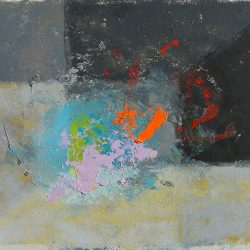Who am I? What is the world? What is reality? These, the most fundamental questions about existence, are at the heart of Martin Henrik’s research, which sees art as a spiritual practice and the works themselves as a condensation of emergent knowledge into concrete objects.
It is from this process of cognition that the paintings and sculptures now on show in Hieron materialise and open up space, and indeed appear as such. The Hieron is a symbol of rectangular space, of the all-embracing nature of Consciousness. The original meaning of the Greek temple is the rectangular space inside the temple that houses the statue of the god. It is here that the reality of the mystery of existence opens up – a space that is itself identified with the superspace reality of the mystery of existence.
In order to construct the geometry of the paintings, Martin has set up postulates, which help to preserve the effect of space on the flat surface of the picture. The material of the sculptures is volcanic rock. By grinding the dark grey andesite, he creates different tonal gradations, so that the planes projected onto the sculpture’s body surfaces are not only spatially separated, but also in shade.
From a formal point of view, Martin sees the abstraction defined by Kazimir Malevich, Josef Albers and Tony Robbin, among others, as a point of contact, while in terms of a purely intellectual approach he sees himself as akin to Lajos Szelényi and Sándor Molnár.

